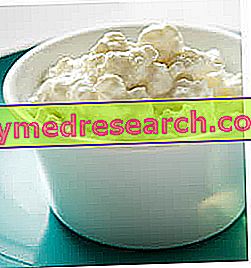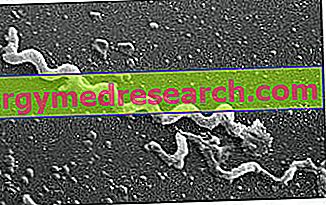What are
The appropriate term to define the cottage cheese is Cottage Cheese ; although this fresh cheese was already widely produced in Central Europe, its commercial distribution and its export overseas were made by US food companies at the beginning of the twentieth century.

Production
The milk flakes are a rather particular dairy product; it is a fresh cheese obtained from skimmed and pasteurized milk curd, produced by coagulation by a small part of rennet and a good part of lactic ferments. Subsequently, the curd of the milk flakes is left to rest until it reaches a predetermined pH (4.8-4.9) then cooked slowly, washed, cooled, dried and added to some thickeners such as flour (carob flour) or alginate of sodium; to facilitate the formation of cottage cheese, the introduction of air is allowed to increase the volume of the product.
At the end of the cheesemaking, to enhance the taste and aroma of cottage cheese, in the traditional recipe the addition of cream (milk cream) is provided; this procedure considerably increases the percentage of fat content, originally moderated by the use of skimmed milk rather than whole or semi-skimmed milk.
One of the most important dietary benefits of cottage cheese is the very low intake of food sodium.
Homemade Milk Flakes
And here, punctually as always, the recipe of our personal cooker Alice that in the kitchen of MypersonaltrainerTv explains in detail how to make cottage cheese.
Homemade Milk Flakes
X Problems with video playback? Reload from YouTube Go to Video Page Go to Video Recipes Section Watch the video on youtubeNutritional Properties
For 100g of edible part, the "low-fat cheese flakes" bring:
- Energy 115 kcal
- Protein 9.7g
- Glucidi 3, 2g
- Lipids 7, 1g
- Sodium 290mg
The values shown are related to one of the most lipid-rich products compared to the average of those sold (up to 9g of lipids per 100g of product). Currently, the most purchased milk flakes are those "light", therefore low in fat (1-4%); obviously, the choice of one or the other cheese is dictated by the need to sacrifice / prefer the taste or lightness of the food.
The milk flakes prove interesting from a protein standpoint ; unlike most cheeses and dairy products, in addition to containing caseins, they also contain a good percentage of whey protein. Furthermore, the characteristic aspect of cottage cheese is the versatility of use in diet therapy.
If they are appreciated by the subject, cottage cheese may be recommended (such as cow's milk ricotta) even for patients suffering from dyslipidemia or hypertension, without significantly affecting the intake of saturated fat, cholesterol and sodium chloride (obviously, respecting the principle of frequency of consumption of cheeses: maximum 2 times a week).



